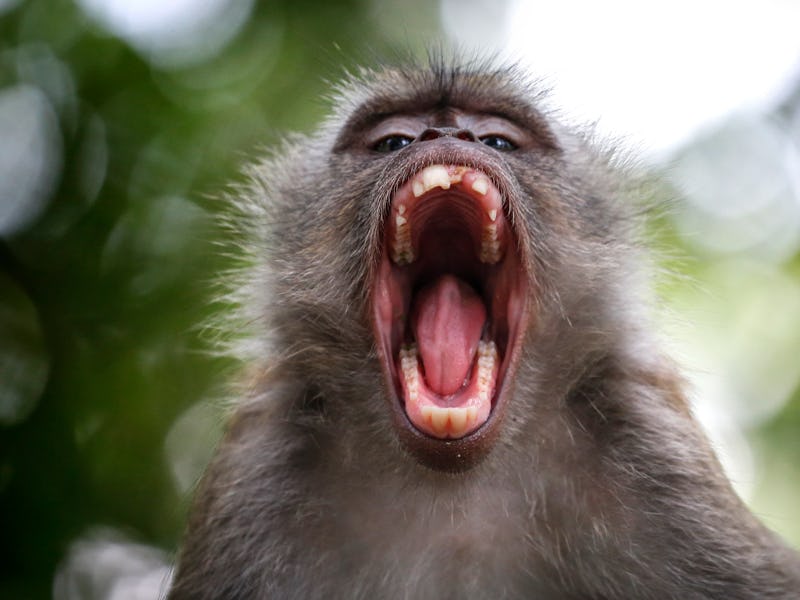Humans gave up screaming in favor of speaking, researchers find
What we lost in range we gained in precision.

Evolution may persuade some that everything about humans is more complex than in their animal predecessors: brain, taste, communication. But perhaps the simplification of one pivotal structure is exactly what makes humans capable of speech.
Researchers from Europe and Japan have investigated a structure in the primate larynx, or voice box, that humans once possessed but no longer have. They examined larynxes with these anatomical features in dozens of other primate genera and species. In their findings published this week in the journal Science, they point to this loss as a stunning example in which simplification of anatomy actually led to the complexity of ability.
What’s new — Human vocalization resembles the same process in other animals. The lungs send air through the vocal cords, making them vibrate to create sound. The biggest difference is that human vocal cords are more stable, and lack additional folds that many primates have.
“If you think about a flagpole in the wind, [it] resonates and vibrates,” animal behavior psychologist Harold Gouzoules tells Inverse. “But when you add the flag ... you can appreciate the notion of chaos and unpredictability.” Gouzoules, a professor at Emory University, was not involved with the research but reviewed the study for publication and authored a companion essay diving into the work.
Human vocal cords are just the pole; they vibrate and move with air stimulation, but are fairly stable. The flags represent vocal membranes that primates still have. Their erratic movement can create a greater range of sound but is much more difficult to control. While researchers have known about these vocal membranes, this team argues that humans represent a case in which loss of anatomy in part led to a gained capability.
In apes and monkeys, these vocal membranes produce what Gouzoules calls “nonlinear vocal phenomena” which can include those harsh shrieks, technically referred to as “roughness.” This variety of screams serves to help primates bluff and project larger sizes by making a stronger, harsher sound. Humans bluff and project size in a more nuanced way.
“It’s not size and fighting ability that determines your status. It’s who you know, who you can influence,” Gouzoules says. We didn’t need a great scream library to survive, so “probably the diminished need for just physical bluster opened the door for us to lose that those structures,” he says.
Why it matters — Finding the crux of how humans evolved the ability for spoken language has been a great challenge.
“[L]anguage evolution is one of the most enigmatic evolutionary events,” lead author Takeshi Nishimura at Kyoto University’s Primate Research Institute writes to Inverse.
While all animals can communicate, as far as we know only humans communicate with speech.
“Speech is the vocal manifestation of language,” Gouzoules says. “No [other] animal can communicate about the past, the present, the future, mythical creatures, or anything like that. Language gives us so much more in the way of an ability to depict and categorize and inform one another about the world.”
One marker of speech is the ability to learn “novel vocalizations,” or acquire new ways of expression and communication. Apes and monkeys have an extensive vocal repertoire, Gouzoules says, but that appears to be entirely inherited. These forms of communication are not speech itself, but rather precursors to speech.
Digging into the details — There’s an evolutionary theory called “use it or lose it.” The idea posits that a creature either keeps a physical or genetic feature in the gene pool by using it to survive, or it slowly phases out. Gouzoules points out that the loss of vocal membranes in humans exemplifies “use it or lose it.”
But it’s not this evolutionary loss alone that created speech. The combination of simplified vocal cords and novel neural pathways is what led humans to standardized speech. Gouzoules says there’s not sufficient evidence to solve this chicken-egg question of whether the structures disappeared first, or whether neural pathways began forming first.
Of the 29 genera and 44 species of primates examined in this study, all possess the vocal membrane except for humans. Lead author Nishimura and his team dug into this structure’s function by observing live chimpanzees as well as using preserved larynxes taken from dead animals and pumping air through them. They also took a mathematical modeling approach to show how the membranes affect a sound’s acoustical form, and how its absence creates something different altogether.
“All the evidence converges on the conclusion that the loss of these vocal membranes was key to generating a stable vocal source,” Gouzoules says.
What’s next — This conclusion still comes with many questions. For example, while humans don’t have the same vast screaming ability, we still retain an understanding of this cruder expression. A parent can recognize their child’s distinct scream of delight or pain. A trained actor can produce a very convincing scream of any kind.
“But clearly we’re not producing them with the same kind of structural arsenal that the animals are,” Gouzoules says. He’s curious about the reason for why we can still recognize this roughness, even if we can’t produce it at the same caliber.
The chicken-egg question looms large, too. “The results of this study reaffirmed the need to understand the biological basis and co-evolution of neural, physiological, and physical faculties and restrictions for such volitional and sophisticated ability of speech in order to further deepen our understanding of the evolutionary processes of speech,” Nishimura writes. The loss of these vocal membranes is another piece of the puzzle, but it exists in the intricate context of human evolution of other systems.
While primates have more colorful shrieks, on a hard day one can either articulate at length what a dismal, wretched, blighted reality they’ve got — or they can still enjoy a good, albeit boring, old-fashioned scream.
This article was originally published on